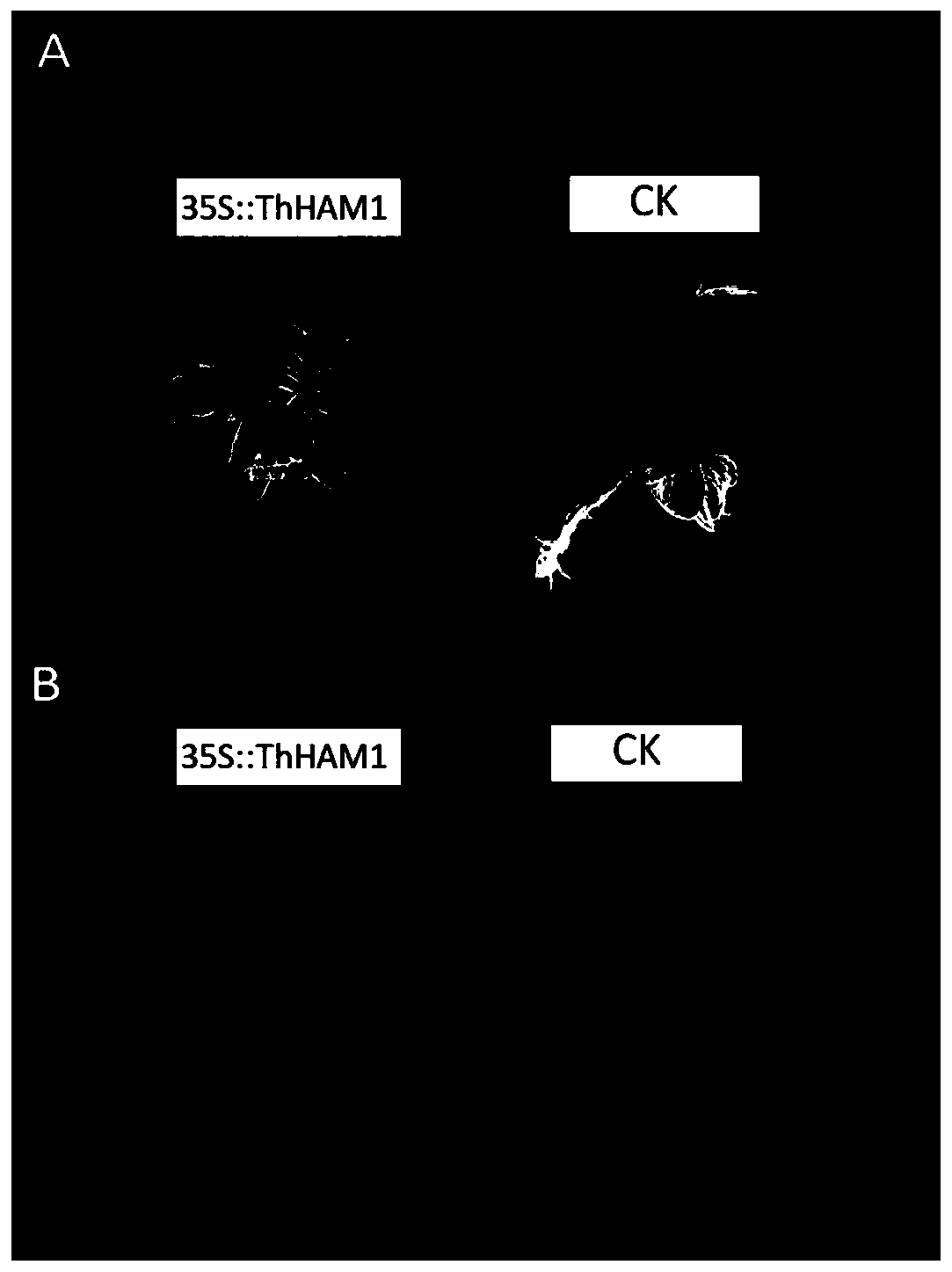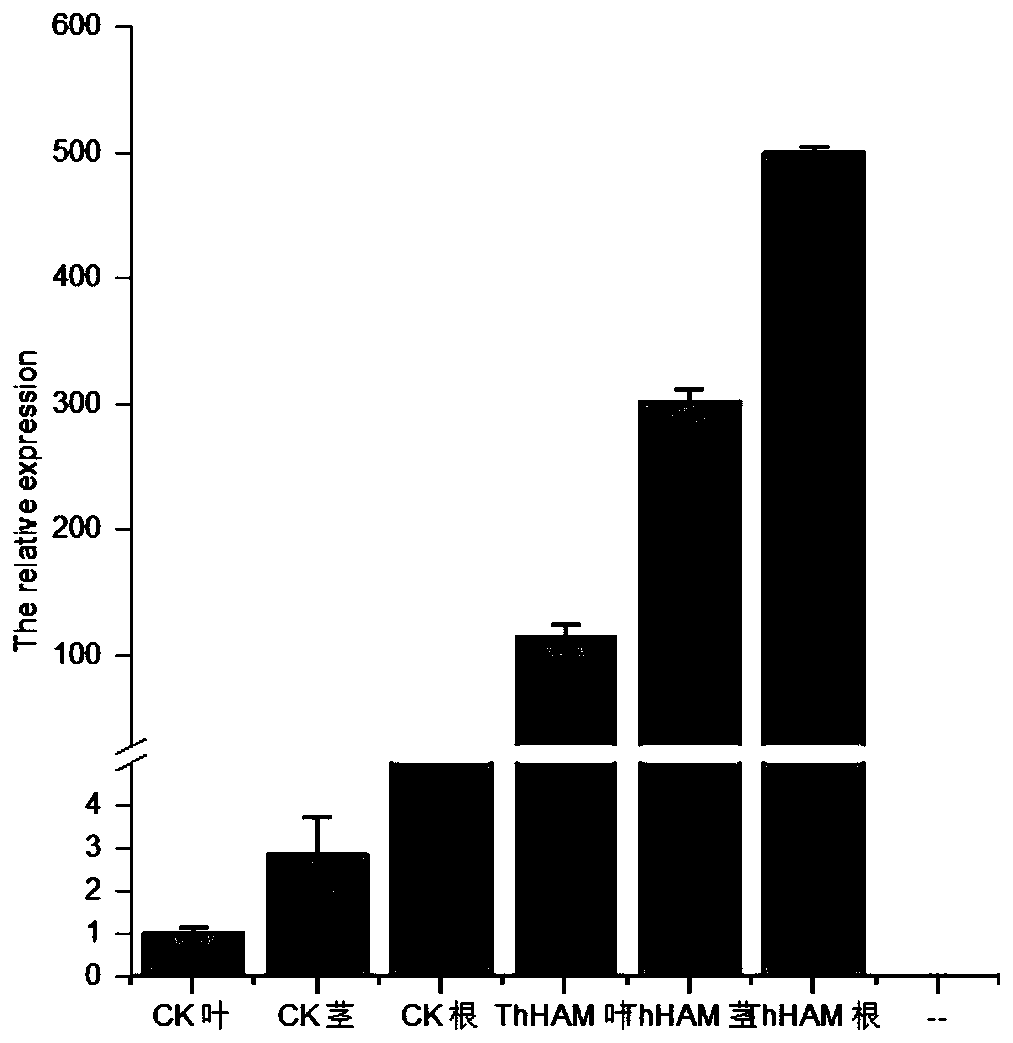ThHAM1 gene related to development of roots of taxodium zhongshansha and application for ThHAM1 gene
A technology for root development and Chinese fir, applied to the ThHAM1 gene and its application field, can solve the problems of the decline of the rooting ability of the clonal line, the difference in rooting ability, and the insignificant effect, and achieve the effect of reducing the number of adventitious roots and slowing down the growth rate.
- Summary
- Abstract
- Description
- Claims
- Application Information
AI Technical Summary
Problems solved by technology
Method used
Image
Examples
Embodiment 1
[0019] Example 1: Cloning of ThHAM1 gene by RACE technology
[0020] 1) Extraction of RNA and inversion of cDNA
[0021] Using Zhongshanshanshan 406 (Taxodium mucronatum♀×T.distichum♂) (T.hybrid ‘Zhongshanshan 406’) plants as materials, total RNA was extracted using RNAprep Pure Polysaccharide and Polyphenol Plant Total RNA Extraction Kit (TIANGEN Company). Before extracting RNA, all pipette tips, centrifuge tubes, and mortars should be soaked in 0.1% DEPC water overnight, autoclaved for 40 minutes, and then dried. All solutions should be prepared in 0.1% DEPC water. The extracted RNA was treated with DNase (Tiangen Biochemical Technology Co., Ltd.) to make it purified. The concentration and purity of total RNA were measured with NanoDrop2000 (ThermoScientific). And use 2.0% agarose gel electrophoresis to separate the total RNA. Afterwards, the 3'RACE and 5'RACE kits of Invitrogen were used to obtain the nucleic acid sequence between the 3' end and the 5' end of the gene. ...
Embodiment 2
[0043] Embodiment 2: ThHAM1 gene plant expression vector construction
[0044] Using Gateway directional cloning technology, the obtained ORF fragment of the target gene is transferred to the target expression vector, including two parts: BP reaction and LR reaction. The carrier map used in this embodiment is as follows figure 1 shown.
[0045] 1) The purpose of the BP reaction is to transfer the gene fragment to the entry vector, the reaction system: vectorThHAM1 ORF fragment 10-20ng, Salt solution 1μL, pCRTM8 / GW / TOPOTMvector (entry vector) 1μL, add Nuclease-free Water to a total volume of 6μL, Mix gently, react at 22°C for 60 minutes, and then transfer to ice; transform 6 μL of the reaction product from the previous step into TOP10 competent cells, spread on LB screening culture plates, and pick single clones for bacterial liquid PCR detection, the primers used are gene Specific upstream primers and T7 primers on the carrier, and the positive clones after detection were fu...
Embodiment 3
[0047] Example 3: Genetic transformation of ThHAM1 gene
[0048] The ThHAM1 gene was transformed into Agrobacterium by liquid nitrogen freeze-thaw method, and then the hybrid Populus montana was transformed by leaf disc method. Operation steps: add at least 100ng of recovered and purified expression vector to EHA105 competent cells, mix gently, ice bath for 30min, quick freeze in liquid nitrogen for 1min, heat shock at 37°C for 3min, quickly place on ice for 1-2min, add 800μL LB Culture medium, 28°C, 100rmp recovery for 3h, 4000rmp centrifugation for 3min, suck off 800μL LB medium, mix the remaining bacterial solution, smear on the LB plate containing antibiotics, 28°C inverted culture for 30-48h, positive clones detected by PCR, positive Propagate the cloned colonies, inoculate in 120mL LB liquid medium containing corresponding antibiotics, and culture at 28°C for about 24 hours until OD 600 The value is about 0.5, divide the bacterial solution into 50mL centrifuge tubes, ce...
PUM
 Login to View More
Login to View More Abstract
Description
Claims
Application Information
 Login to View More
Login to View More - R&D
- Intellectual Property
- Life Sciences
- Materials
- Tech Scout
- Unparalleled Data Quality
- Higher Quality Content
- 60% Fewer Hallucinations
Browse by: Latest US Patents, China's latest patents, Technical Efficacy Thesaurus, Application Domain, Technology Topic, Popular Technical Reports.
© 2025 PatSnap. All rights reserved.Legal|Privacy policy|Modern Slavery Act Transparency Statement|Sitemap|About US| Contact US: help@patsnap.com


